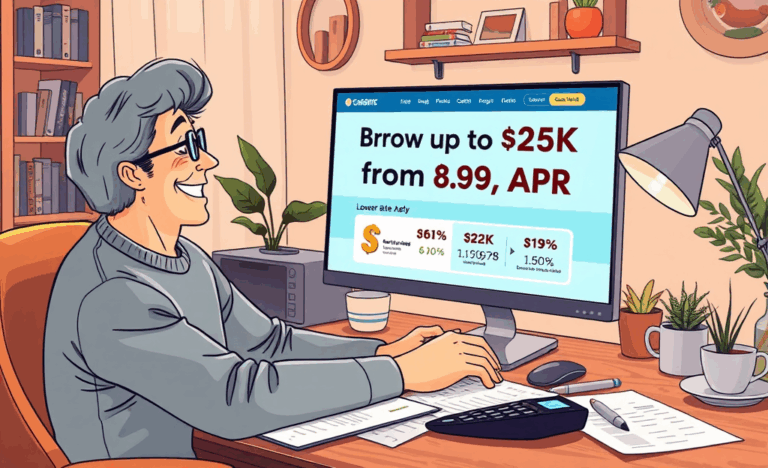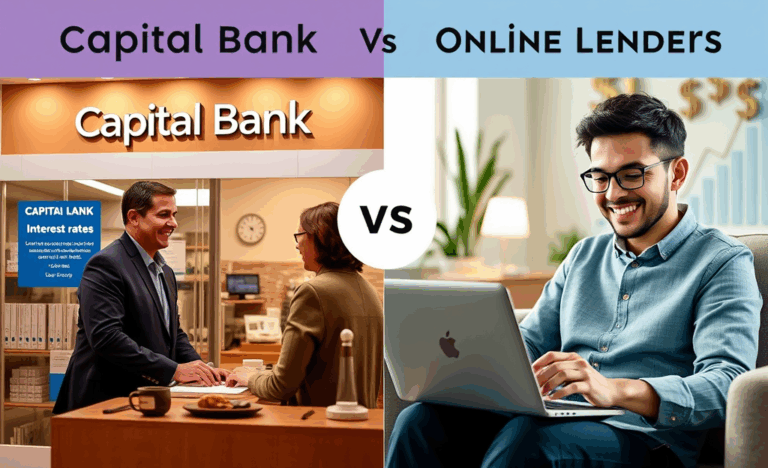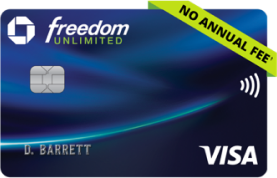![]()
![]()
![]()
![]()
Loans for Bad Credit Exist Get Up to 20K Today
Bad Credit shouldn’t hold you back from accessing the financial support you need.
In this article, we will explore the various loan options available for individuals with less-than-perfect credit scores, including how to secure loans of up to $20,000.
We’ll examine the different lenders who cater to those with bad credit, discuss what you can expect in terms of interest rates and fees, and highlight the importance of prequalification processes.
Whether you’re facing an emergency situation or looking to consolidate debt, there are tailored solutions that can help you regain control of your finances.
Reality Check: Borrowing with Bad Credit
Think a bad credit score shuts every financial door? Think again.
The common belief that poor credit automatically disqualifies you from borrowing is simply false.
Today’s lending landscape has changed dramatically, and more options are now tailored to fit individuals in unique financial situations.
From emergency expenses to debt consolidation, personal loans are now within reach—even for those whose credit scores are less than perfect.
In fact, You CAN be approved for funding amounts reaching as high as $20,000, depending on the lender’s criteria and your financial profile.
That’s not just wishful thinking—it’s a financial possibility more people are experiencing every day.
Lenders like OneMain Financial and others are breaking the outdated narrative by offering loan options specifically designed for people managing bad credit.
They understand that a credit score doesn’t always tell the full story.
Because of this, many allow prequalification steps with no impact to your credit—a smart way to explore your options confidently.
So if you’ve been holding back from applying, it’s time to take a fresh look.
This could be your moment to move forward with confidence and control—and the journey starts right here.
What Makes Bad Credit Loans Possible
Bad-credit loans are financial products specifically tailored for borrowers with low credit scores—typically below 580 on the standard 300–850 scale.
Unlike conventional loans that heavily weigh a borrower’s credit report, bad-credit loans provide access to funding based on alternative data, often emphasizing current income and overall financial stability.
According to Bankrate’s overview of bad credit personal loans, these products often bridge the gap for individuals who don’t qualify through traditional banks, making them essential for urgent needs like medical expenses or sudden home repairs
These loans differ from mainstream financing in their criteria and structure.
Lenders compensate for credit risk in several ways:
- Flexible underwriting: Lenders may use recent income and employment stability instead of focusing solely on credit scores
- Higher but fixed rates: Borrowers pay more in interest, but fixed terms offer predictability over loan duration
- Focus on income: Stable, verifiable income plays a greater role in approval than past credit performance
Borrowers should still approach these products with caution, as Credible notes in their analysis that poor management can worsen one’s credit further, while responsible repayment may help rebuild it gradually
How to Secure up to $20,000 with a Low Score
Qualifying for a $20,000 loan with bad credit depends on demonstrating financial stability in other areas.
A key factor is proof of steady income.
For instance, a borrower with a credit score of 560 but a stable job might improve their chances by submitting recent pay stubs, W-2s, and bank statements showing consistent deposits.
Lenders like Credible’s lending partners may consider such documentation, especially if the borrower maintains low living expenses.
Reducing your debt-to-income ratio before applying is another way to appear more creditworthy.
One borrower reduced monthly credit card payments by consolidating smaller debts, then waited 90 days while maintaining a low credit utilization rate.
This preparation made them eligible for better lending terms despite their poor credit.
Another effective strategy involves providing collateral or a co-signer.
Offering a vehicle with clear title or home equity can turn the loan into a secured one, lowering the lender’s risk.
Alternatively, a co-signer with strong credit can also improve approval odds.
A single mom needing emergency funds used her father as a co-signer through Acorn Finance’s network, helping her secure the full $20,000. Lenders evaluate the co-signer’s credit and income, not just the primary borrower’s, which shifts the overall risk profile.
By aligning these factors, even borrowers with low scores can access needed capital.
Where to Find Lenders When Your Credit Is Low
When your credit score is low, knowing where to look can make a big difference in securing a loan.
Online lenders stand out for their convenience and fast approval processes.
Many of these platforms specialize in helping borrowers with poor credit, often providing prequalification tools that let you check estimated rates with no impact on your credit report.
Some trusted sources, like LendingTree personal loans for bad credit, serve as aggregators, letting you compare multiple lenders at once, streamlining your decision-making process.
On the other hand, credit unions tend to offer more personalized services and competitive rates, with more flexibility for members with low scores.
Since they’re nonprofit organizations, credit unions can evaluate your financial picture more comprehensively, rather than relying solely on credit numbers.
Peer-to-peer lenders connect borrowers directly with investors.
This model offers customized terms and a range of offers, potentially easing the way for those with subprime credit.
Lastly, community banks may consider local ties and banking history, helping them extend credit even in high-risk circumstances.
These banks often lean on personal relationships to help you qualify for critical funding, making them a trusted choice when national lenders won’t say yes
Rates, Fees, and Total Cost
Borrowers with bad credit should be aware that these loans often come with elevated interest rates and added fees which can significantly raise the total repayment amount over time.
Many lenders see low credit scores as red flags, so they offset that risk with higher costs.
Always read the terms carefully before signing because what may seem like fast cash could lead to long-term debt.
Carefully review all fees and rates to avoid financial surprises.
Some lenders offer prequalification with no credit impact—an essential step to compare realistic offers.
For example, platforms like LendingTree’s bad credit loan options display rate ranges up to 35.99% APR.
Keep in mind that certain origination fees and late charges may also apply.
Below is an overview of typical cost structures for bad-credit personal loans:
| Fee/Rate Type | Typical Range | What It Covers |
|---|---|---|
| APR | 15%–36% | Interest on principal |
| Origination Fee | 1%–8% | Loan processing and disbursal |
| Late Payment Fee | $15–$40 | Missed or delayed payments |
| Prepayment Penalty | 0%–5% | Early loan payoff |
| NSF Fee | $20–$35 | Failed payment due to insufficient funds |
Why Prequalification Matters
Prequalification plays a crucial role for borrowers with bad credit looking for personal loans, streamlining the process and reducing the risk of negative credit impacts.
Instead of sending multiple applications that trigger hard credit checks, bad-credit applicants can now turn to prequalification with a trusted lending platform, which uses a soft credit pull.
This means credit scores remain unaffected while evaluating eligibility.
Within minutes, borrowers can preview loan amounts, terms, and estimated monthly payments, allowing them to compare offers from multiple lenders before committing.
Platforms like OneMain Financial offer intuitive tools to check for prequalified loan options with no impact on your credit.
This process gives borrowers a strong advantage through better rate insight, no hard-pull impact, time savings through instant feedback, reduced risk of denial, and increased ability to budget accurately.
Altogether, prequalification helps demystify what a lender sees and sets clearer expectations for both approval chances and borrowing limits, ensuring applicants with damaged credit can move forward with more confidence and control.
Smart Uses: Emergencies and Debt Consolidation
Bad-credit loans can become a lifeline when traditional financing isn’t available, especially during unpredictable emergencies.
For instance, unexpected car repairs can leave you stranded—not being able to get to work or manage daily responsibilities.
A personal loan up to $20,000, even with bad credit, is often obtainable through flexible lenders who offer fast funding without impacting your credit score during prequalification.
In situations like a medical emergency, where insurance doesn’t cover all expenses, access to immediate funds can mean the difference between prompt care and overwhelming debt.
Using a loan wisely in this case allows you to pay off urgent bills without falling behind on other obligations.
Debt consolidation is another relevant use for bad-credit personal loans.
Combining high-interest credit card balances or medical bills into one lower-rate installment simplifies finances and often reduces monthly payments.
Several lenders even specialize in this service—like Achieve, known for its flexibility in terms.
According to Experian, this route often leads to better budgeting and reduced stress.
Borrow only what you need; calculate payoff timelines; avoid repeat borrowing
In conclusion, individuals with bad credit have viable options for securing loans.
By exploring different lenders and understanding the process, you can find the financial support needed to address emergencies or manage debt effectively.






